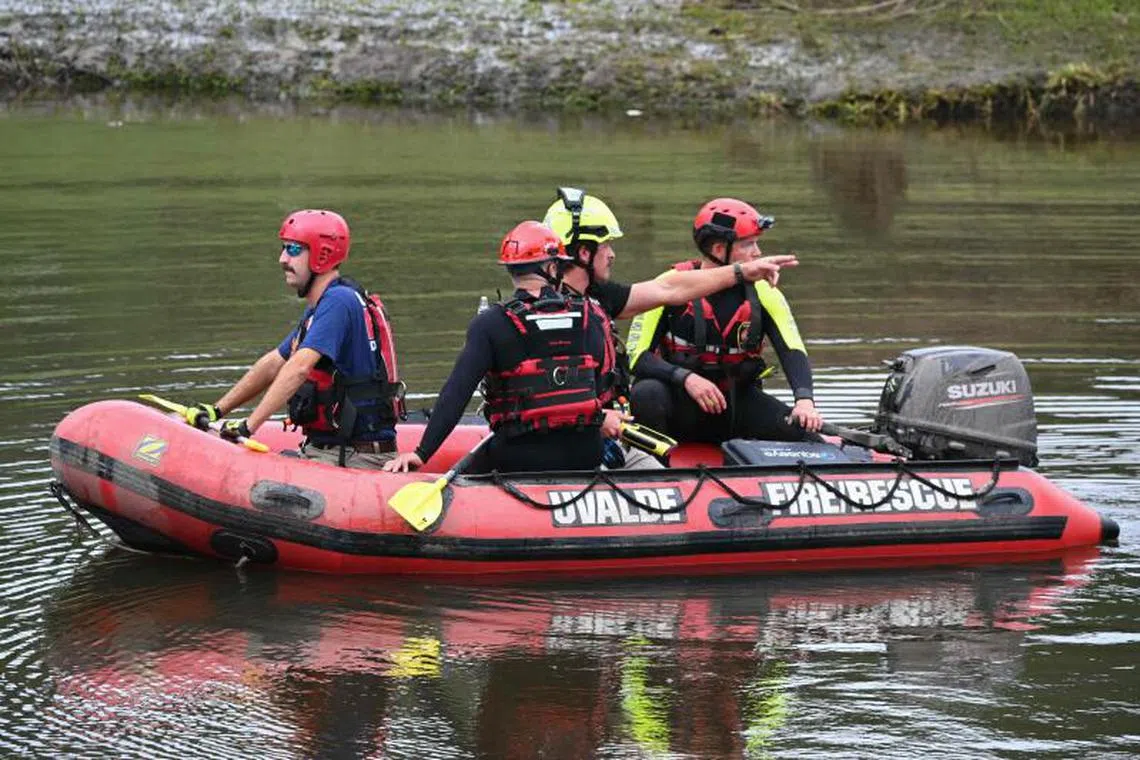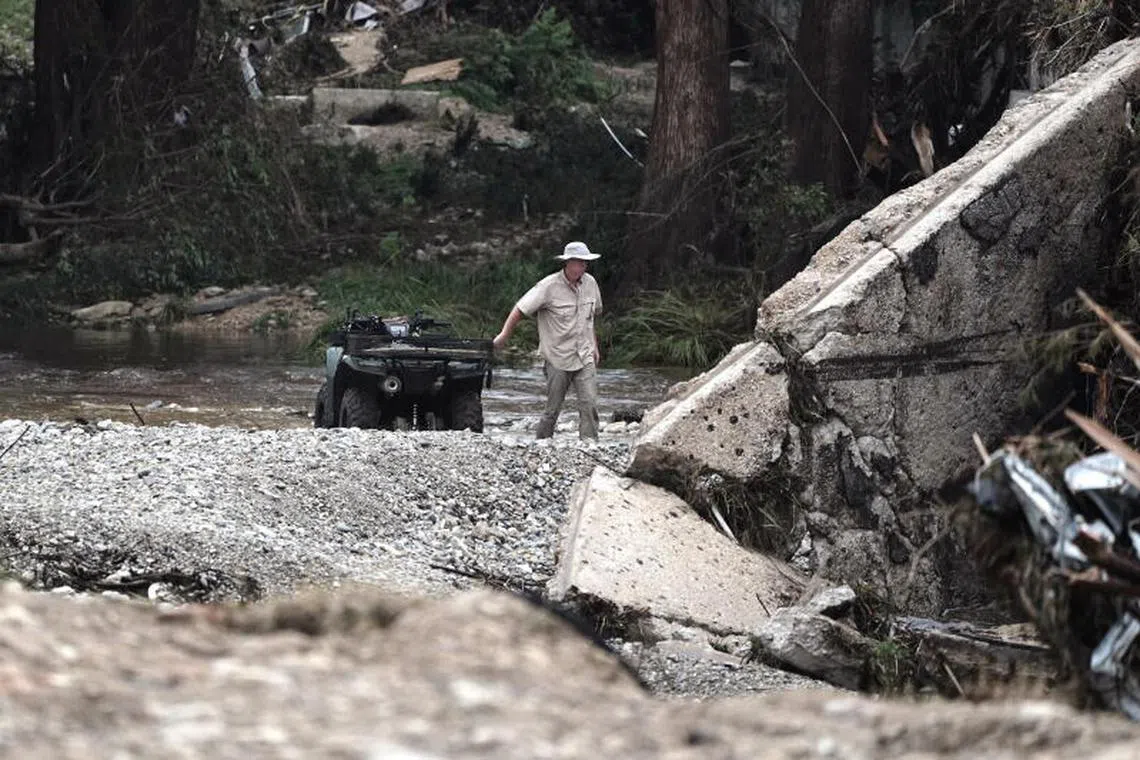‘100-year catastrophe’: Deaths from central Texas flooding surpass 100, officials say
Sign up now: Get ST's newsletters delivered to your inbox

A search and rescue team searching for survivors along the Guadalupe River near Camp Mystic in Hunt, Texas, on July 7.
PHOTO: AFP
Follow topic:
KERRVILLE, Texas – The death toll from catastrophic flooding in central Texas rose to over 100 on July 7, as rescuers continued their grim search for people swept away by torrents of water.
At least 104 flood-related deaths were reported across central Texas.
Kerr County, through which the Guadalupe River runs, was the hardest hit, with at least 84 people killed, including 28 children, according to the local sheriff’s office.
The toll includes 27 who had been staying at Camp Mystic, an all-girls Christian camp that was housing about 750 people when the flood waters struck.
Forecasters have warned of more flooding as rain falls on saturated ground, complicating recovery efforts involving helicopters, boats, dogs and some 1,750 personnel.
“There is still a threat of heavy rain with the potential to cause flooding,” Texas Governor Greg Abbott said in a statement on July 7, with the number of victims expected to rise still.
President Donald Trump confirmed he planned to visit Texas on July 11, as the White House slammed critics claiming his cuts to weather agencies had weakened warning systems.
“Blaming President Trump for these floods is a depraved lie, and it serves no purpose during this time of national mourning,” White House press secretary Karoline Leavitt told reporters on July 7.
She said the National Weather Service (NWS), which The New York Times reported had several key roles in Texas unfilled before the floods, issued “timely and precise forecasts and warnings”.
Mr Trump has described the floods in the early hours of July 4 as a “100-year catastrophe” that “nobody expected”.
The President, who previously said disaster relief should be handled at the state level, has signed a major disaster declaration, activating fresh federal funds and freeing up resources.
‘Every parent’s nightmare’
Kerr County in central Texas has been the hardest hit of the counties devastated by the floods, with 56 adults and 28 children killed, according to the local sheriff’s office.
Camps are a beloved tradition in the long US summer holidays, with children often staying in woods, parks and other rural areas.
Texas Senator Ted Cruz described them as a chance to make “lifetime friends – and then suddenly it turns to tragedy”.
“The children, little girls, who were lost at Camp Mystic, that’s every parent’s nightmare.”
San Antonio mother Nicole Wilson – who almost sent her daughters to Camp Mystic – launched a petition on Change.org urging Mr Abbott to approve a modern warning network.
“Five minutes of that siren going off could have saved every single one of those children,” she told AFP.
At a candlelit vigil in San Antonio on the night of July 7, Texans gathered to pray for the victims of the floods and voice lingering fears.
“I was pretty shocked on the gravity of the situation and how big it was, and I wouldn’t necessarily expect that our rivers would rise so quickly,” said Ms Rebeca Gutierrez, 29.
“Hopefully there’s preventative efforts happening in similar areas to make sure nothing to this degree happens.”
Mr Richard “Dick” Eastland, 70, the co-owner and director of Camp Mystic, died trying to save the children at his camp during the flood, multiple media outlets, including the Austin American-Statesman, reported.
Mr Eastland and his wife Tweety Eastland have owned the camp since 1974, according to the camp’s website.
“If he wasn’t going to die of natural causes, this was the only other way, saving the girls that he so loved and cared for,” Mr Eastland’s grandson George Eastland wrote on Instagram.
‘Flash flood alley’
Some residents were questioning the absence of more robust flood-warning systems in this region of south and central Texas – where such deluges are so frequent that it is known colloquially as “Flash Flood Alley”.
Experts stress the NWS sent out timely forecasts, and climate scientist Daniel Swain pinned the problem on a failure of “warning dissemination”.
Helicopters and boats were taking part in the grim search across an area popular with tourists as well as summer camps.
In a terrifying display of nature’s power, the rain-swollen waters of the Guadalupe River reached treetops and the roofs of cabins as girls at Camp Mystic slept.
Blankets, teddy bears and other belongings were caked in mud. Windows in the cabins were shattered, apparently by the force of the water.
Volunteers were helping to search through debris from the river, with some motivated by personal connections to the victims.
“We’re helping the parents of two of the missing children,” Mr Louis Deppe, 62, told AFP. “The last message they got was ‘We’re being washed away’, and the phone went dead.”

A first responder searching under a bridge spanning the Guadalupe River in Hunt, Texas, on July 6.
PHOTO: EPA
Months’ worth of rain fell in a matter of hours on the night of July 3 into July 4, and rain has continued in bouts since then.
The Guadalupe surged around 8m – more than a two-storey building – in just 45 minutes.
Flash floods occur when the ground is unable to absorb torrential rainfall.
Human-driven climate change has made extreme weather events such as floods, droughts and heat waves more frequent and more intense in recent years. AFP

